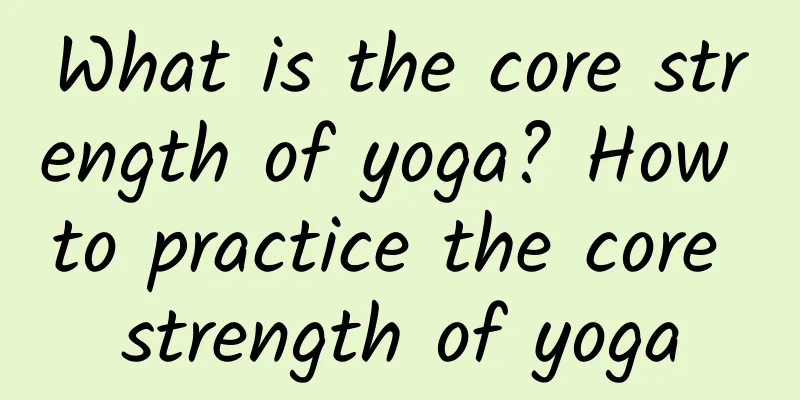What is the core strength of yoga? How to practice the core strength of yoga

|
Whether it is yoga or fitness, the word core strength is mentioned. Related to core strength is the core muscle group, among which abdominal muscle strength is a type of core strength. So how to practice core strength in yoga? What is core strength in yoga?There are four components to the abdominal core. Pelvic floor muscles: These muscles make up your core. They line the bottom of your pelvis and support your abdominal organs. When you use these muscles in yoga, you create a subtle lift in your center, helping to lengthen your spine. Transverse Abdominis: You can think of these as the walls of your core. These muscles surround your entire abdomen, contain your abdominal organs, support your spine, and provide movement for your abdomen. In yoga, the abdominals support your lower back and integrate movement between the spine, pelvis, and ribs. Iliopsoas: The iliopsoas is a combination of the psoas and iliacus, the "core" of the "core." In yoga, the iliopsoas works with your other hip flexors to support you in standing poses, strengthen your forward bends, and support the abdominals in poses like boat pose and arm balances. Diaphragm: Positionally, the diaphragm is the topmost muscle of the core. The diaphragm is the primary muscle involved in breathing. Our spine is wrapped in these muscles, providing support for the body, and it can be said that your core is working at all times. The goal of core strength is to maintain the position of the hips, spine, and ribs, providing a stable base so that movement can be performed effectively. The core muscles are rarely responsible for "generating kinetic movement", but they are key to maintaining good alignment of the body so that power can be transferred through the torso. How to practice core strength in yoga1. Mountain poseKeep your feet together with your big toes touching. If this is uncomfortable, you can move your feet further apart. Begin to engage your leg muscles, pulling your kneecap up toward your abdomen. Engage your core and breathe deeply as your arms remain at your side. Stand on the hill for a full minute. Make sure your legs and core muscles are engaged. 2. Standing forward bendFrom Tadasana, place your palms at the center of your chest and on your next inhale, lift your arms overhead, reaching toward the ceiling. As you exhale, fold forward and try to touch your fingertips to the ground. Remember to pull your abdomen toward your spine when you do this pose. Keep your legs engaged. Hold this position and breathe for 1 minute. Make sure your core muscles are engaged and pulled back toward your spine. 3. Inclined PlankFrom a standing position, bend your knees and place your hands on the ground. Lower your feet back into plank position. This is one of the best abdominal exercises if you are new to exercise or your core strength is not very good. It works by targeting all muscle groups instead of just one. Remember to breathe deeply at any point of discomfort and try to hold the plank for one minute. Try to stay in the plank for a full minute. Keep your core engaged, arms locked, and gaze softly. 4. Four-column supportStart from the plank position, move your body center of gravity forward a little bit, and then slowly lower yourself until your chest is about ten centimeters off the ground and your upper arms are parallel to the ground. Hold for 1 minute. 5. Downward DogPush back from Chaturanga to Plank, then back to Downward Facing Dog. Either keep your feet hip-distance apart or bring them closer together. Stretch your sitting bones upward and lengthen your back. At the same time, press down through your heels, trying to keep your heels on the ground. If your heels can't touch the ground, bend your knees slightly. How to do Upward Dog in YogaPractice method: 1. Lie prone on the mat with the instep of your feet pressed against the ground. 2. Bend your elbows, place your palms on both sides of your body, and keep your forearms perpendicular to the ground. 3. Inhale, press your palms to the ground, straighten your arms, and lift your upper body off the ground. At the same time, press the instep of your feet to the ground, tighten your thigh muscles, lift your thighs slightly, and lift your knees off the ground. 4. Exhale and hold. While holding, fully stretch your upper body, lengthen your neck, and tilt your head back. |
Recommend
Abdominal pain on the fourth day after miscarriage
There are many reasons for miscarriage, some are ...
What kind of fish is used to make wind-blown fish? Which kind of fish is the most delicious?
As we all know, wind-blown fish is a common delic...
Oral diseases caused by taking medicine (Part 2)
In the previous article, we simply introduced two...
Can pregnant women eat rice vinegar?
Pregnant women can naturally eat rice vinegar. Th...
Female reproductive anatomy
The functions of the female vagina are the reprod...
What to do if you have a lot of saliva during early pregnancy
Since pregnancy, due to more or less changes in a...
How does Traditional Chinese Medicine treat moderate cervical erosion?
Many women suffer from cervical erosion due to va...
Bleeding again after abortion
Abortion is generally divided into two types: nat...
What medicine to take during menopause
Many women will suffer from insomnia after enteri...
Can I use a pregnancy test kit to detect pregnancy one month later?
There are some special symptoms that can be seen ...
How to get rid of freckles?
As people's living standards improve, their p...
What should I pay attention to after kidney stone surgery? These are critical
Kidney stones are one of the common diseases in l...
How to preserve mustard tuber? Where is the hometown of mustard tuber?
Zhacai is a semi-dried non-fermented pickle made ...
What are the physical symptoms of normal menstruation?
Menstruation refers to the periodic shedding and ...
Don’t fall into these “pitfalls” of myopia surgery again!
Many people with myopia have experienced that &qu...









